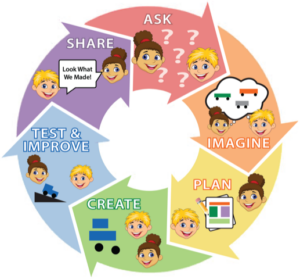Robotics in Early Childhood Education – The Engineering Design Process Develops Grit and Perseverance
In the last part of the blog series, we share key reasons why early childhood educators should be incorporating robotics in their classrooms. In this blog, we are focusing on Key #6 – The Engineering Design Process Develops Grit and Perseverance! See the other blogs in this series about the importance of robots in early learning with STEAM learning tools:
- Key 1 – Robotics in Early Childhood Education – Coding Teaches STEAM, the Literacy of the 21st Century
- Key 2 – Robotics in Early Childhood Education – Coding Develops Computational Thinking Skills
- Key 3 – Robotics in Early Childhood Education – Technology Becomes the Playground
- Key 4 – Robotics in Early Childhood Education – Robotics Makes Coding Tangible, Concrete…and Screen-Free!
- Key 5 – Robotics in Early Childhood Education – Using Technology Breaks Down Engineering Stereotypes
Early childhood is a wonderful time to sparks kids’ interest in coding, robotics, and engineering. Young children are naturally curious about the world around them. Today, that world includes technology. But how can educators promote positive, creative, and educational engagement with technology with our youngest learners? Integrating STEM Engineering Kits, robots and coding for early learners is easier than you may think, with hands-on, screen-free tools like KIBO.
Robotics in Early Childhood Education – The Engineering Design Process Develops Grit and Perseverance

Working with STEM Engineering Kits such as KIBO, especially when facilitated in a classroom, means engaging with the engineering design process. This process encourages young children to identify a problem, imagine and plan a solution, build and test their creation, and share their work with peers. In this process, things won’t always work as intended – ask any engineer! The process is set up to expect young students to test, fix, and debug their work, so students focus on continually making changes and improvements rather than on being right or wrong – a “growth mindset.” As they seek input and advice from peers, children also develop collaborative social skills around a shared project.
Research states, “Many children are held back in their learning because they have a model of learning in which you have either ‘got it’ or ‘got it wrong.’ But when you program a computer you almost never get it right the first time… The question to ask about the program is not whether it is right or wrong, but if it is fixable.” (Papert, 1980)
When working with KIBO, the STEM Engineering Kit, along with KinderLab’s STEAM curriculum, children are guided through the Engineering Design Process right from the start, first by building and testing sturdy craft constructions and later applying the process to all of their robotics projects. KIBO gives young children clear and concrete feedback about whether their programs are working as intended, and the wooden block programming language makes revision easy. Each lesson ends with a circle time where kids share the challenges they encountered and trade ideas for improvements.
Learn the 6 Key Benefits of Using Robotics with Your Youngest Students!
![]() Introduce coding and robotics into your early childhood classrooms – in a fun and playful way!
Introduce coding and robotics into your early childhood classrooms – in a fun and playful way!
The Engineering Design Process and 21st Century Skills
Engaging with the engineering design process also allows early childhood educators to help students develop vital skills for 21st century work. The nonprofit Partnership for 21st Century Learning describes “four C’s” of learning and innovation that are central to student success in the 21st century: Creativity and Innovation; Critical Thinking and Problem Solving; Communication; and Collaboration. The steps of the engineering process, supported by STEM engineering kits like KIBO, allow young children to develop all of these critical 21st century skills. Working in groups they imagine and design solutions to problems, they test and improve their creations, and they share both the process and the results with their peers in collaborative reflection.
What KIBO Robotics Offer Young Learners
KIBO, the coding robot, offers an inviting, engaging platform for children to start their journey into creating with code. KIBO’s block-based coding language gives children control over the robot’s movements, sounds, and sensors, allowing them to express their imaginations with code. And, when accompanied by our STEAM curriculum, children are able to tell stories, create characters, and explore their world with KIBO.
Learn more about how the KIBO Robot can teach the fundamentals of programming in a fun and engaging way and our mission to introduce coding to children by watching Dr. Marina Bers’ Tedx Talk – Young programmers — think playgrounds, not playpens.
Supporting research:
- Papert, S. (1980). Mindstorms: Children, computers and powerful ideas. New York: Basic books.
- Dweck, Carol S. (2008). Mindset: The new psychology of success. New York, NY: Ballantine Books.
- Bers, M. (2012). Designing digital experiences for positive youth development: From playpen to playground. Cary, NC: Oxford.



















